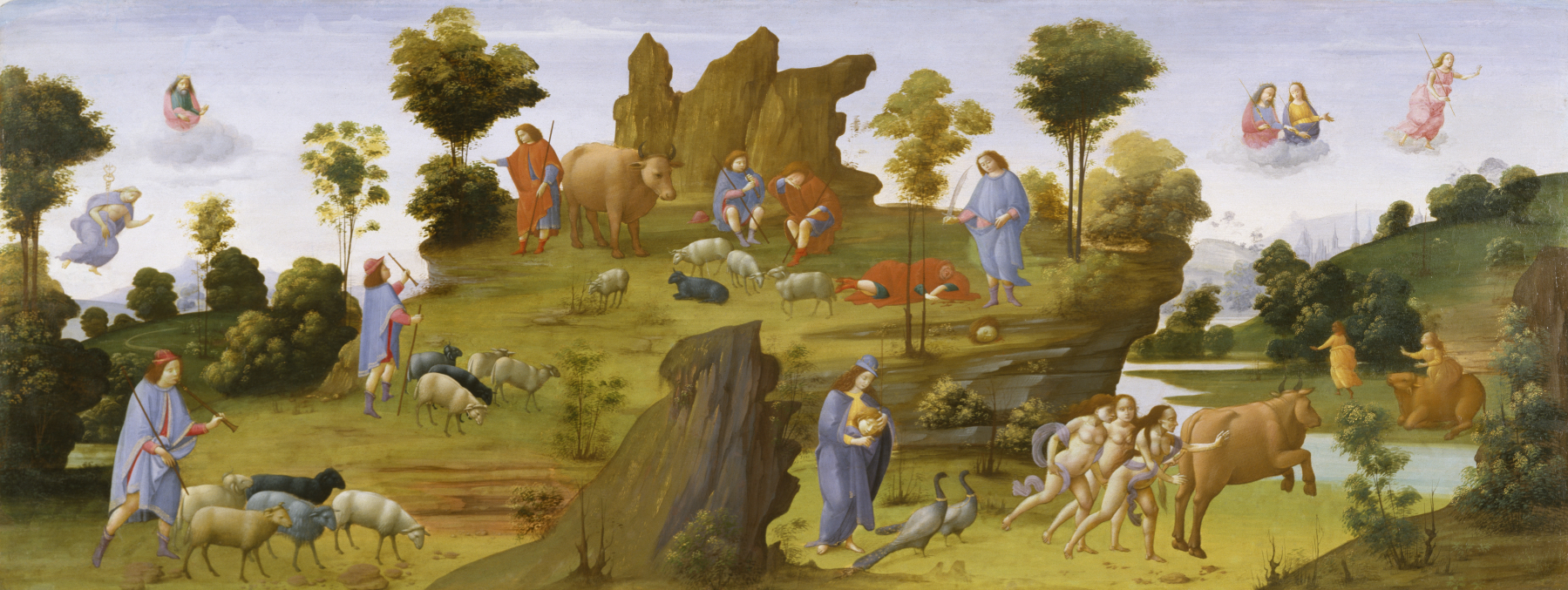The Myth of Io
(Renaissance Europe )
As told by the Roman poet Ovid (43 BCE-17 CE) in his "Metamorphoses," the beautiful nymph Io was seduced by Jupiter, king of the gods, and transformed into a heifer by Jupiter’s jealous wife, Juno. This painting, when read from left to right, illustrates multiple episodes in the second half of this story, in which Io is transformed back into a human. The narrative begins in the upper left with Jupiter emerging from the clouds and ordering the messenger god Mercury to rescue Io. After disguising himself as a shepherd (lower left), Mercury approaches the hundred-eyed monster Argus (here depicted as a two-eyed shepherd) who, on Juno’s orders, holds Io captive among his flock. Mercury lulls Argus to sleep with his reed pipe and then beheads him (upper center), freeing Io. Angry that her plans have been thwarted, Juno removes Argus’s hundred eyes and uses them to decorate the tail feathers of her sacred bird, the peacock (lower center). She then sends the Three Furies to torment Io, who escapes to the Nile River (lower right). Jupiter finally convinces his wife to stop tormenting Io (upper right) and transforms the former nymph back into human form (lower right). Io escapes into the woods and becomes the Egyptian goddess Isis, flying off into the sky in the upper right corner.
Along with a second panel depicting the first half of the story (now at the Castle Museum in Berchtesgaden, Germany), the painting was originally installed in the wall of the room in a Florentine palace as a “spalliera” panel. Deriving from the Italian word “spalla,” meaning shoulder--a reference to the average height at which such pictures were installed--spalliera panels were often commissioned by the groom's family to celebrate marriages. They usually depict stories with moralizing themes for newlywed couples. In this case, Io was likely understood as a model of patience. The Florentine painter Bartolomeo di Giovanni, best remembered as an occasional collaborator of his more famous contemporaries Sandro Botticelli (1445-1510) and Domenico Ghirlandaio (1449-1494), was a specialist in the production of spalliera panels.
Provenance
Provenance (from the French provenir, 'to come from/forth') is the chronology of the ownership, custody, or location of a historical object. Learn more about provenance at the Walters.
Taymouth Castle, Braedalbane, Scotland [date and mode of acquisition unknown]; Mrs. Baillie-Hamilton, Langton, Berwickshire, Scotland, by 1903 [mode of acquisition unknown]; Henry Walters, Baltimore, 1911, by purchase [Bernard Berenson as agent]; Walters Art Museum, 1931, by bequest.
Exhibitions
| 1998-2001 | Highlights from the Collection. The Walters Art Gallery, Baltimore. |
Conservation
| Date | Description | Narrative |
|---|---|---|
| 9/22/1939 | Treatment | coated; loss compensation |
| 11/22/1939 | Treatment | loss compensation; stabilized; varnish removed or reduced |
| 2/21/1940 | Treatment | repaired; cleaned; loss compensation; coated |
| 1/1/1953 | Examination | examined for condition |
| 7/7/1965 | Examination | examined for condition |
| 12/14/1981 | Treatment | cleaned; coated; loss compensation |
| 12/14/1981 | Treatment | cleaned; inpainted; loss compensation; surface cleaned; varnish removed or reduced |
| 6/10/1982 | Treatment | cleaned; filled; inpainted; surface cleaned; varnish removed or reduced |
| 1/1/1997 | Treatment | repaired; loss compensation; other |
| 3/1/1997 | Treatment | inpainted; loss compensation; repaired; splits mended; stabilized |
Geographies
Italy, Florence (Place of Origin)
Measurements
Painted surface H: 25 9/16 x W: 67 1/2 x D: 1 1/4 in. (65 x 171.5 x 3.2 cm)
Credit Line
Acquired by Henry Walters, 1911
Location in Museum
Accession Number
In libraries, galleries, museums, and archives, an accession number is a unique identifier assigned to each object in the collection.
In libraries, galleries, museums, and archives, an accession number is a unique identifier assigned to each object in the collection.
37.421


